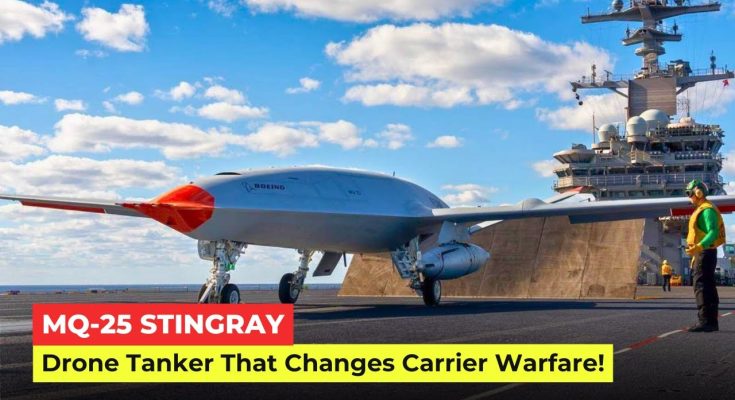The MQ-25 Stingray, developed by Boeing for the U.S. Navy, represents a significant leap in naval aviation and could fundamentally alter the way carrier warfare is conducted. As the first unmanned aerial tanker specifically designed to refuel other aircraft in midair, the MQ-25 has the potential to revolutionize the operational flexibility and reach of aircraft carriers. In this article, we will explore how this innovative drone tanker could change the future of carrier warfare forever.
The Need for Aerial Refueling in Carrier Operations
Aerial refueling has long been a critical capability for military aviation, particularly for enhancing the range and endurance of aircraft. For carrier-based aircraft, the ability to conduct air-to-air refueling extends their operational range, allowing them to perform long-range strike missions, conduct sustained air superiority operations, and respond rapidly to emerging threats over vast oceanic expanses. Traditionally, aircraft carriers have relied on manned tanker aircraft, such as the KC-135 Stratotanker or KA-6D Intruder, to refuel other aircraft in flight.
However, manned tankers on aircraft carriers are limited by the availability of crew and the need for specialized aircraft to perform refueling missions. This limitation makes the carrier air wing less flexible in terms of range and mission endurance, especially in highly contested environments where tanker aircraft could become vulnerable to enemy threats. This is where the MQ-25 Stingray comes into play.
The MQ-25 Stingray: A Game-Changer for Carrier Warfare
The MQ-25 Stingray is designed to operate as an unmanned aerial tanker for aircraft carriers, enabling the Navy to significantly increase the operational reach of its fighter and strike aircraft without relying on manned tankers. The MQ-25 is equipped with state-of-the-art refueling equipment and is capable of refueling fixed-wing fighters such as the F/A-18 Super Hornet, F-35C Lightning II, and other aircraft deployed on the carrier. It can extend the combat radius of these aircraft, allowing them to strike targets further inland and operate for longer durations, without the need to return to the carrier for refueling.
One of the most compelling aspects of the MQ-25 Stingray is its ability to operate autonomously. Unlike traditional manned tankers, the MQ-25 is unmanned and can be controlled remotely, which provides several advantages in combat scenarios. With no crew on board, the risk to personnel is eliminated, and the aircraft can operate in high-risk environments where manned tankers might be vulnerable to enemy defenses.
Additionally, because the MQ-25 is designed as a drone, it can be more cost-effective to operate and maintain than traditional manned tanker aircraft. It is also designed to be modular, meaning it can be quickly adapted or reconfigured for other roles, including intelligence gathering, surveillance, and reconnaissance (ISR), depending on the mission requirements. This versatility adds further value to the MQ-25 in a dynamic and fast-changing combat environment.
Enhancing Operational Flexibility
The introduction of the MQ-25 Stingray will provide aircraft carriers with enhanced operational flexibility. With the MQ-25 handling aerial refueling duties, it allows other aircraft in the carrier air wing to focus on their primary missions, such as combat air patrols, strike missions, and reconnaissance. The increased endurance of these aircraft will make the carrier air wing more effective and efficient, allowing for sustained operations in farther and more dangerous zones.
By increasing the range of carrier-based strike fighters like the F/A-18 Super Hornet and the F-35C, the MQ-25 also helps offset the limitations posed by the relatively small range of carrier-based aircraft. This would be especially beneficial in areas like the South China Sea or the Persian Gulf, where air assets need to cover vast distances over water. Additionally, the MQ-25’s ability to refuel aircraft while maintaining an autonomous flight profile ensures that carriers are less dependent on logistical support and can focus more on offensive and defensive operations.
Changing the Nature of Carrier Warfare
The advent of unmanned tanker drones like the MQ-25 will not only change the logistics of carrier warfare but will also impact the broader strategies of naval combat. With extended operational ranges and autonomous capabilities, the MQ-25 allows for a more distributed and flexible approach to carrier operations. In the future, the U.S. Navy may operate fewer manned tankers, relying instead on a fleet of MQ-25 drones to extend the reach of its fighter and strike aircraft.
Moreover, the ability to refuel aircraft in-flight opens up new possibilities for carrier strike groups to conduct long-range strike missions against targets far from the coast. This flexibility could be critical in high-intensity conflicts or situations where U.S. naval forces need to project power without the need to establish a nearby airbase.
Conclusion
The MQ-25 Stingray is poised to redefine the future of carrier warfare by providing aircraft carriers with an innovative and cost-effective solution for aerial refueling. By introducing an unmanned tanker system, the MQ-25 offers greater flexibility, endurance, and reach for carrier air wings, transforming the way the U.S. Navy conducts long-range strike missions. As the Navy continues to deploy and integrate the MQ-25 into its operations, it will undoubtedly shape the future of naval aviation, creating new opportunities for power projection and operational success. The era of unmanned aerial tankers has arrived, and the MQ-25 Stingray could very well be the catalyst for a new chapter in carrier warfare.



